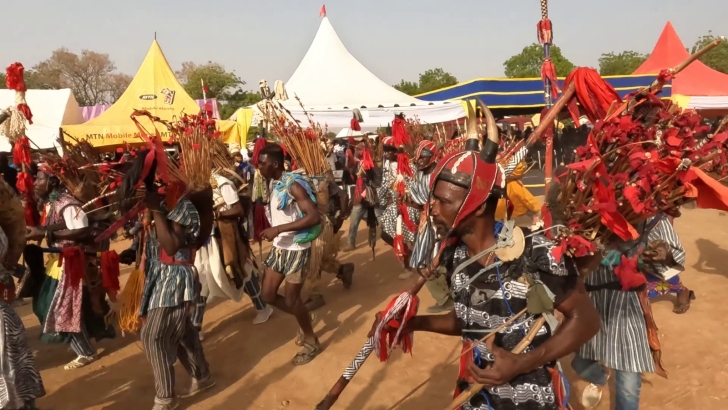How sons and daughters of Kassena-Nankana in Navrongo celebrated Fao Festival
Traditional festivals can simply be referred to as cultural events or celebrations by traditional areas often organised annually, primarily to venerate the ancestors, thank the gods and to remember notable events in history.
Festivals constitute a series of cultural activities culminating into a spiritual product, which has been developed during the evolution of the people.
It is therefore the case that most indigenes would relish the celebration of their festivals because aside the spiritual significance, it is an occasion for reunion and the promotion of development of their respective areas.
I was particularly enthused when I saw flyers announcing the celebration of Fao Festival celebrated by the sons and daughters of the Kassena-Nankana of Navrongo.
My excitement stemmed from the fact that the festival has not been celebrated for some time now and because as a son of the land, I always want to be associated with anything that has to do with my roots.
So, on the 29th of December, 2023, the festival day, I woke up with some inner joy and excitement. With the assistance of my mother and younger sister, Jean-Marie, I tried the numerous smocks of my late father to see which one would best fit the occasion.
My excitement was even heightened when a neighbour came to request for my late father’s walking stick to complete his attire for the occasion.
Fao festival is celebrated by the people of Navrongo and its environs as a major thanksgiving celebration to commemorate the end of the farming season and to thank the gods and ancestors for the provision of adequate rains throughout the crop season. The festival also affords the people the opportunity to show gratitude to the ancestors for their protection over the period.
An occasion that was supposed to begin at 10:00 am sadly took off at about 3:00 pm. Notwithstanding, let me congratulate the organizers for their efforts. It was a beautiful sight to behold of men and women dressed in their resplendent smocks and other traditional attire of various sizes, colours and shapes. One could behold various sounds and sights of traditional drumming, dancing and the age-old war dance exhibited by powerful and fearful looking warriors carrying their charms and amulets.

Of course, their magical display, which portrays the degree of potency of their magic included cutting parts of their bodies without any form of injury, quenching fire with their mouths without sustaining burns, among many other displays. One remarkable observation at the durbar grounds was the number of young men and women, an indication of the youthful population we have in Navrongo. I saw their presence as both a positive and a negative.
As a positive, we can harness this youthful population full of enormous energy, varied skills, and qualifications for the development of the area. But as a negative, we missed a glorious opportunity to really demonstrate and show our young people who have never witnessed the celebration of Fao the true form and nature of celebrating the festival.
In all honesty, despite the beautiful sights and sounds that greeted the occasion, I felt the general organization of the event did not meet the expectations of many. Navrongo abound in many people with rich organizational experience, which could have been brought on board, but I am not sure the organizers took the opportunity to tap into the experience of such. As stated above, the time for the commencement of the durbar of chiefs and people was grossly disrespected. Many dignitaries got tired of waiting and had to leave.
One notable observation, which is so regrettable is the way the chiefs entered the durbar grounds. I stand to be corrected but my little recollection of culture is that all the subchiefs of the traditional area are supposed to converge at the chief palace of the paramount chief for the performance of some rituals after which a beautiful entourage will herald the entry into the durbar grounds of all the chiefs, accompanied by drumming and dancing.
The paramount chief will be the last to announce his presence at the grounds before commencement of the programme. Unfortunately, some chiefs arrived after the paramount chief.
My humble suggestions for the future in relation to the organization of our festival are as follows.
- Broad inclusion. The planning committee should as much as possibly include people from the various communities as well as from natives in the diaspora.
- Planning should begin very early in the year.
- The publicity should be very wide and should include as many media forms as possible.
- Inclusion of various activities that would involve both the old and the young. These activities can include cultural, academic, religious, sports, health etc.
- Sponsorship should be sought from corporate bodies and individuals for the various activities.

There is no reason why we cannot brand the Fao Festival to be an event that will not only bring sons and daughters of the land from far and near together, but it would be a major tourist event of the year.
Other areas have such success stories and are reaping the benefits of their deliberate and careful planning of their festivals.
As said earlier, the efforts are commendable and we can right our wrongs, learn useful lessons, call one other to order and if possible, crack the whip to bring back the lost glorious days that were associated with Fao.
I will also use this medium to encourage our compatriots who had high expectations of the festival like me and have been disappointed to remain positive and come on board next time around.
We have one Navrongo and we all must put our shoulders to the wheel no matter what to achieve the desired results.




